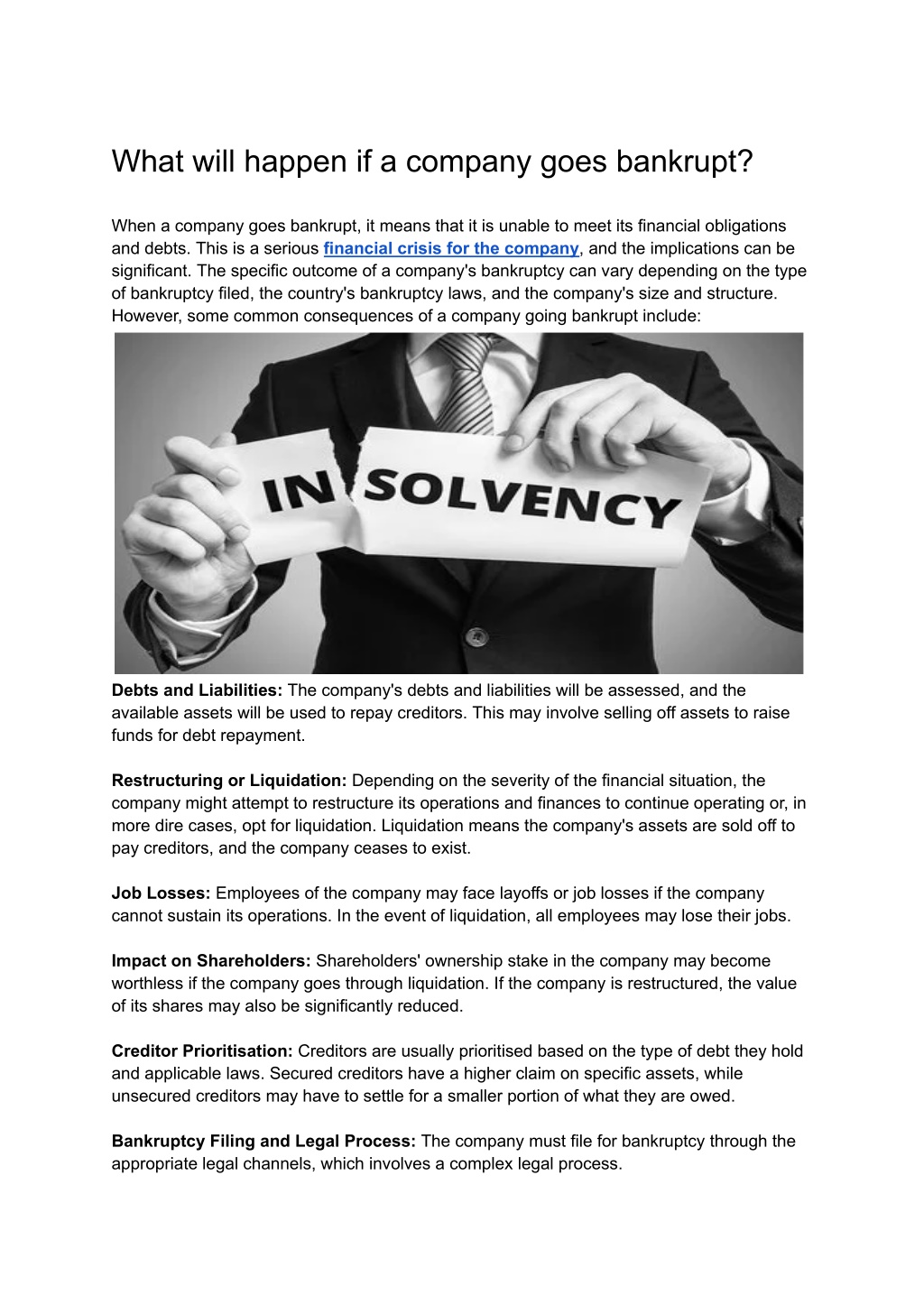Understanding Company Administration: What Happens When a Company Goes into Administration in the UK?
Understanding Company Administration: What Happens When a Company Goes into Administration in the UK?
Blog Article
The Process and Repercussions of a Firm Coming In Administration
As a company deals with monetary distress, the choice to get in management marks a crucial point that can have significant ramifications for all included events. The procedure of getting in management is detailed, involving a series of actions that intend to browse the firm in the direction of possible recuperation or, in some situations, liquidation. Recognizing the duties and duties of a manager, the influence on numerous stakeholders, and the lawful responsibilities that come into play is necessary in understanding the gravity of this scenario. The effects of such a step surge beyond the company itself, shaping its future trajectory and affecting the more comprehensive service landscape.

Summary of Firm Administration Refine
In the world of company restructuring, a vital initial step is obtaining a detailed understanding of the detailed business management process. Company management refers to the formal bankruptcy treatment that aims to save a financially distressed business or attain a far better result for the firm's financial institutions than would certainly be feasible in a liquidation situation. This process entails the visit of an administrator, who takes control of the company from its directors to evaluate the monetary situation and determine the best strategy.
Throughout management, the firm is approved defense from lawsuit by its creditors, providing a moratorium period to develop a restructuring strategy. The administrator collaborates with the company's monitoring, creditors, and other stakeholders to develop an approach that may involve offering the service as a going problem, getting to a firm voluntary plan (CVA) with financial institutions, or eventually positioning the firm right into liquidation if rescue efforts prove useless. The key objective of firm management is to make the most of the return to creditors while either returning the company to solvency or closing it down in an orderly manner.
Duties and Duties of Manager
Playing a crucial duty in looking after the firm's decision-making processes and financial affairs, the manager presumes considerable responsibilities during the company restructuring procedure. The primary responsibility of the manager is to act in the very best passions of the firm's financial institutions, intending to attain one of the most desirable result possible. what happens when a company goes into administration. This involves conducting an extensive analysis of the firm's monetary situation, developing a restructuring strategy, and implementing approaches to maximize go back to creditors
In addition, the administrator is responsible for communicating with various stakeholders, consisting of employees, distributors, and regulatory bodies, to guarantee openness and compliance throughout the management process. They have to likewise connect successfully with investors, providing normal updates on the company's development and seeking their input when necessary.
Additionally, the administrator plays a vital role in handling the everyday operations of the organization, making vital choices to maintain continuity and maintain value. This includes examining the viability of different restructuring alternatives, negotiating with lenders, and eventually leading the company towards a successful leave from management.
Effect On Business Stakeholders
Thinking a vital setting in managing the business's monetary affairs and decision-making processes, the administrator's activities throughout the corporate restructuring process have a direct impact on numerous firm stakeholders. Investors might experience a decline in the value of their investments as the firm's economic troubles are addressed. Financial institutions, consisting of loan providers and providers, may encounter unpredictabilities relating to the payment of debts owed to them. Workers typically experience job instabilities because of potential discharges or modifications in job problems as part of the restructuring initiatives. Consumers might experience interruptions in solutions or item accessibility during the management process, affecting their trust fund and loyalty towards the company. Additionally, the neighborhood where the firm operates might be impacted by potential job losses or changes in the company's operations, influencing regional economies. Reliable interaction from the administrator to stakeholders is important in handling expectations, mitigating problems, and cultivating transparency throughout the management process.
Lawful Effects and Commitments
Throughout the process of company management, mindful factor to consider of the legal implications and commitments is extremely important to ensure conformity and secure the rate of interests of all stakeholders involved. When a firm gets in administration, it triggers a collection of legal requirements that have to be stuck to.
Furthermore, legal effects occur concerning the therapy of workers. The manager needs to follow work legislations regarding redundancies, staff member legal rights, and obligations to give needed information to staff member representatives. into administration. Failure to abide by these legal needs can result in lawsuit versus the business or its managers
Moreover, the company entering management might have legal responsibilities with different parties, consisting of clients, landlords, and distributors. These contracts need to be assessed to determine the most effective strategy, whether to terminate, renegotiate, or satisfy them. Failure to manage these legal obligations appropriately can result in conflicts and possible lawful effects. Essentially, understanding and meeting legal responsibilities are critical aspects of navigating a company through the administration process.
Strategies for Firm Healing or Liquidation
In thinking about the future direction of a firm in administration, strategic preparation for either healing or liquidation is important to chart a practical path onward. When aiming for firm healing, essential strategies might include performing a complete analysis of the organization procedures to determine ineffectiveness, renegotiating contracts or leases to improve cash money flow, and applying cost-cutting procedures to enhance earnings. Additionally, looking for new investment or funding options, expanding income streams, and concentrating on read review core competencies can all add to a successful healing strategy.
On the other hand, in circumstances where company liquidation is considered the most proper course of action, approaches would include making the most of the worth of assets with reliable asset sales, working out arrearages in an organized fashion, and abiding by lawful needs to ensure a smooth winding-up process. Communication with stakeholders, consisting of staff members, creditors, and customers, is important in either circumstance to keep openness and handle assumptions throughout the recuperation or liquidation process. Inevitably, picking the right technique depends upon a thorough analysis of the company's monetary health, market position, and long-term leads.
Verdict
To conclude, the process of a firm getting in administration involves the consultation of a manager, that handles the duties of taking care of the company's events. This procedure can have look what i found significant repercussions for various stakeholders, consisting of workers, lenders, and shareholders. It is necessary for business to thoroughly consider their alternatives and techniques for either recovering from monetary problems or waging liquidation in order to alleviate potential lawful implications and responsibilities.
Business administration refers to the official insolvency treatment that aims to rescue an economically distressed firm or attain a far better outcome for the firm's creditors than would certainly be feasible in a liquidation circumstance. The manager functions with the company's monitoring, creditors, and various other stakeholders to develop a strategy that might include offering the organization as a going concern, reaching a firm volunteer arrangement (CVA) with financial institutions, or eventually positioning the business right into liquidation if rescue attempts confirm useless. The primary goal of company management is to make best use of the return to financial institutions while either returning the company to solvency or closing it down in an orderly way.

Report this page